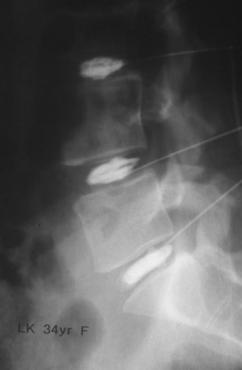Plain X-Rays, CAT and MRI scans, myelograms and other radiological investigations demonstrate the anatomy of the spine, they do not show us where pain comes from. It is also important to remember that degenerative changes are common and may not be the cause of your pain. In an ideal world we would have an investigation that could identify the origin of your pain. Historically discography has been used as a provocative investigation to determine whether degenerative changes are indeed associated with pain generation. However the utility of the investigation has been called into question in recent years, and nowadays discography is rarely employed. For completeness, Information on discography is detailed below.

Discography is a procedure in which a needle is placed into an intervertebral disc and fluid (a contrast medium or dye) is injected as shown.
Local anaesthetic is used to numb the skin where the needle is inserted. As fluid is injected into the disc you may be aware of no discomfort, a sensation of pressure or mild discomfort, or the type of pain you usually have.
It is important that you tell the doctor performing the injections exactly what you are experiencing when asked.
It is usual to inject several discs at the same time. This is done to ensure that all painful discs are identified.
Sedation is usually used to reduce your discomfort during the procedure. You will be awake enough to tell the surgeon what you are experiencing during the procedure, but you will usually have no, or very little, recollection of the procedure itself following its completion.
You should expect your usual symptoms to be aggravated by this procedure for several days. In some cases it may be necessary to remain in hospital overnight, but in most cases patients are able to leave hospital on the same day.
The results of discography may assist your surgeon in advising you about the chance of success of a spinal fusion.
